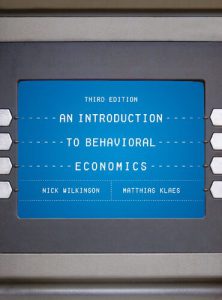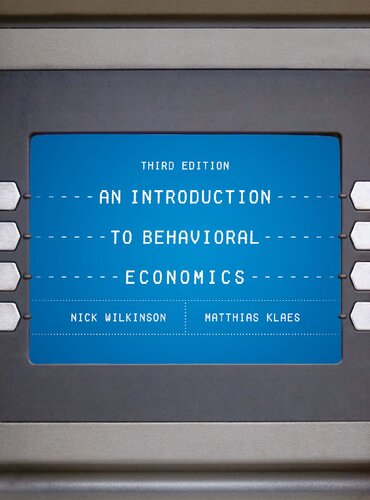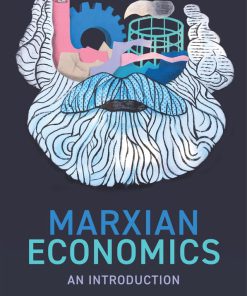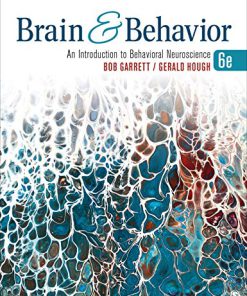An Introduction to Behavioral Economics 3rd Edition by Nick Wilkinson, Matthias Klaes 9781137524133 1137524138
$50.00 Original price was: $50.00.$25.00Current price is: $25.00.
An Introduction to Behavioral Economics 3rd Edition Nick Wilkinson – Ebook Instant Download/Delivery ISBN(s): 9781137524126,113752412X,9781137524133 ,1137524138

Product details:
- ISBN 10: Nick Wilkinson Matthias Klaes 9781137524133, 1137524138
- ISBN 13: 9781137524133
- Author: Nick Wilkinson, Matthias Klaes
An Introduction to Behavioral Economics
Table contents:
Part I: Introduction
Chapter 1. Nature of Behavioral Economics
1.1 Behavioral economics and the standard model
1.2 History and evolution of behavioral economics
1.3 Relationship with other disciplines
1.4 Objectives, scope and structure
1.5 Summary
1.6 Review questions
1.7 Applications
Case 1.1 Loss-aversion in monkeys
Case 1.2 Money illusion
Chapter 2. Methodology
2.1 Theories
2.2 Evidence
2.3 Consilience
2.4 Summary
2.5 Review questions
2.6 Applications
Case 2.1 Altruism and the brain
Case 2.2 Riots in the UK
Part II: Foundations
Chapter 3. Values, Preferences and Choices
3.1 The neoclassical model
3.2 Axioms, assumptions and definitions
3.3 The evolutionary biology of utility
3.4 The neuroscientific basis of utility
3.5 Broadening rationality
3.6 Visceral factors
3.7 Types of utility
3.8 Policy implications
3.9 Summary
3.10 Review questions
3.11 Applications
Case 3.1 Drug addiction
Case 3.2 When abstention is better than moderate consumption
Case 3.3 The psychology of supermarket selling
Chapter 4. Beliefs and Expectations
4.1 The neoclassical model
4.2 Probability estimation
4.3 Self-evaluation bias
4.4 Magical beliefs
4.5 Causes of irrationality
4.6 Summary
4.7 Review questions
4.8 Review problems
4.9 Applications
Case 4.1 Trading on testosterone
Case 4.2 Celebrity contagion and imitative magic
Case 4.3 Trump, Brexit and post-truth politics
Chapter 5. Decision-making under Risk and Uncertainty
5.1 Background
5.2 Conventional approaches to modifying expected utility theory
5.3 Prospect theory
5.4 Reference points
5.5 Loss-aversion
5.6 Shape of the utility function
5.7 Decision-weighting
5.8 Criticisms of prospect theory
5.9 Recent theories and conclusions
5.10 Summary
5.11 Review questions
5.12 Review problems
5.13 Applications
Case 5.1 The endowment effect
Case 5.2 Loss-Aversion In Golf
Case 5.3 Serving size and eating habits
Chapter 6. Mental Accounting
6.1 Nature and components of mental accounting
6.2 Framing and editing
6.3 Budgeting and fungibility
6.4 Choice bracketing and dynamics
6.5 Policy implications
6.6 Summary
6.7 Review questions
6.8 Applications
Case 6.1 The equity premium puzzle
Case 6.2 Why you can’t find a cab on a rainy day
Case 6.3 The housing market and debt
Part III: Intertemporal Choice
Chapter 7. The Discounted Utility Model
7.1 Introduction
7.2 Origins of the discounted utility model
7.3 Features of the discounted utility model
7.4 Methodology
7.5 Anomalies in the discounted utility model
7.6 Summary
7.7 Review questions
7.8 Applications
Case 7.1 The measurement of discount rates
Chapter 8. Alternative Intertemporal Choice Models
8.1 Time preference
8.2 Time-inconsistent preferences
8.3 Hyperbolic discounting
8.4 Modifying the instantaneous utility function
8.5 More radical models
8.6 Empirical evidence
8.7 Policy implications
8.8 Summary
8.9 Review questions
8.10 Applications
Case 8.1 Price plans for gym memberships
Case 8.2 The savings problem
Case 8.3 The desire for rising consumption profiles
Case 8.4 Payday loans
Case 8.5 Financial crashes
Part IV: Strategic Interaction
Chapter 9. Behavioral Game Theory
9.1 Nature of behavioral game theory
9.2 Solution concepts
9.3 Mixed strategies
9.4 Bargaining
9.5 Iterated games
9.6 Signaling
9.7 Learning
9.8 Summary
9.9 Review questions
9.10 Review problems
9.11 Applications
Case 9.1 Penalty kicking in professional soccer
Case 9.2 Bargaining and self-serving bias
Case 9.3 Market entry in monopoly
Chapter 10. Social Preferences
10.1 The neoclassical model
10.2 The nature of social preferences
10.3 Factors affecting social preferences
10.4 Modeling social preferences
10.5 Inequality-aversion models
10.6 Reciprocity models
10.7 Empirical evidence
10.8 Policy implications
10.9 Summary
10.10 Review questions
10.11 Applications
Case 10.1 The Wason test
Case 10.2 Public goods and free-riding
Case 10.3 Sales force compensation
Case 10.4 Obesity, diet and health
Part V: Conclusion
Chapter 11. Behavioral Economics: Summary and Outlook
11.1 The agenda of behavioral economics
11.2 Criticisms of behavioral economics
11.3 Methodology
11.4 Are we really irrational?
11.5 Welfare and happiness
11.6 Problems in pursuing happiness
11.7 Policy implications
11.8 Future directions for behavioral economics
11.9 Applications
Case 11.1 The effects of brain damage on decision-making
Case 11.2 The bioeconomic causes of war
Case 11.3 Getting children to eat vegetables
People also search:
an introduction to behavioral economics 3rd edition
an introduction to behavioral economics pdf
introduction to behavioral economics
an introduction to the economics of information pdf
an introduction to behavioural ecology 4th edition pdf
You may also like…
Science (General)
Uncategorized
Psychology - Neuropsychology
Uncategorized
Introduction to Air Transport Economics From Theory to Applications 3rd Edition Bijan Vasigh
Computers - Artificial Intelligence (AI)
An Introduction to Machine Learning 3rd Edition by Miroslav Kubat ISBN 3030819353 9783030819354
Business & Economics - Mathematical Economics
Quantum Economics and Finance: An Applied Mathematics Introduction 3rd Edition David Orrell
Uncategorized
Criminal Profiling: An Introduction to Behavioral Evidence Analysis 5th Edition Brent E. Turvey












